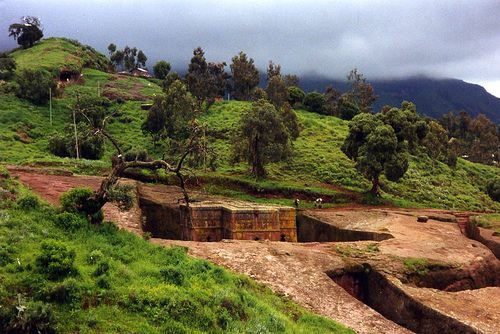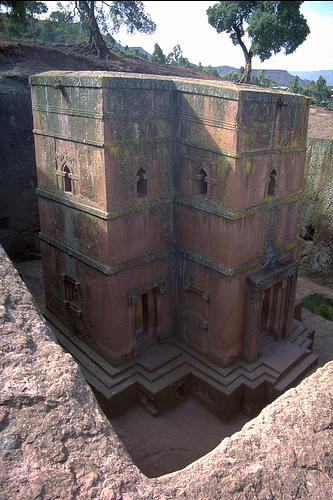

Location: Amhara Region Map
Open: 8am- 12pm, 2- 5pm
Religious
Europe
Asia
Africa
Lalibela is famous for its monolithic Ethiopian Orthodox churches carved from the solid rock in the Amhara Region of Ethiopia. Lalibela structures and even geologic locations were modelled and named after Jerusalem after its fall to the Muslim troops of the Saladin in 1187. The central river of Jordan flows through the religious complex of Lalibela. Churches are connected with tunnels and bridges cut in the lava rock. The largest and most beautiful church in the complex is Bet Giyorgis Church or Church of Saint George who is considered to be a heavenly protector of Lalibela and all of Ethiopia.


Lalibela is famous for its monolithic Ethiopian Orthodox churches carved from the solid rock in the Amhara Region of Ethiopia. The structures and even geologic locations were modelled and named after Jerusalem after its fall to the Muslim troops of the Saladin in 1187. The central river of Jordan flows through the religious complex. Churches are connected with tunnels and bridges cut in the lava rock. The largest and most beautiful church in the complex is Bet Giyorgis Church or Church of Saint George who is considered to be a heavenly protector of Ethiopia.
The beginning of the rock structures of Lalibela date back to the middle of the 12th century. Young prince Gebre Mesqel Lalibela, which means "the bees recognize his sovereignty" in Old Agaw language, was born to the Zagwe Dynasty. The legend claims that a swarm of wild bees surrendered him at birth. They didn't touch him so family members took it as a great sign. He left his homeland for a pilgrimage to the Holy Land. He spend 13 years in Jerusalem and its surroundings. But invasion of Muslim armies under leadership of Saladin cut short his trip there so he had to return home. Upon arrival he tried to lead chaste life. However his older brother Charbey became jealous of him and he even tried poison him. However God's angels descended from the sky at night and lifted young prince to the sky. There he met God who ordered him construction of an alternative Jerusalem, since travel to the Muslim lands became too dangerous for Christians. He was also told that his should not fear for his life since nothing will touch him. The story also claims that the same angels visited Charbey and told him to give up his throne for the younger brother. Both travelled to a city of Roha that is known today as Lalibela. They ordered construction of a new pilgrimage site modelled after Lalibela's experience in the Holy Land. The river was renamed Jordan and thirteen separate churches were cut in the rock and connected with separate tunnels.
King Lalibela led a good life as a king of the country. He left a column with inscriptions as a guide for his people. Today it kept in the Church of Bet Maryam or Church of Saint Mary. However only priest can see it since it is covered by colourful clothes. After the death of a just king he was proclaimed as a saint by the Ethiopian Orthodox Church. Today religious completed of Lalibela is alive and active. A village of Lalibela situated near by numbers around 10,000 people, which includes over 1000 priests who serve here.
Bet Medhane Alem is situated in the Northern group of Lalibela. It is the largest temple in the Lalibela group of churches. It measures 23.5 by 33.5 meters with a height of 11.5 meters. General appearance of the structure is very similar to the ancient Greek and Roman temples. Two rows of windows allow light inside the church. If you get permission you might be allowed to see golden cross that is kept here. However ancient artifact was stolen and subsequently recovered, so locals are often unwilling to allow many tourists inside Bet Medhane Alem.
These two churches are twin churches in the Northern part of the complex. Bet Mika'el or Church of Saint Michael is an anteroom of the Selassie Chapel. It contains three monolithic altars cut in the side of the mountain. It is rarely open to the public. Bet Golgotha or Church of Golgotha (hill near Jerusalem where Jesus was crucified) on the other hand is open to the public. It contains symbolic representation of the Tomb of Christ as well as tomb of great king Lalibela, the founder of the complex. The church also contains large prayer stick and a metal cross that is once belonged to the legendary ruler. Unfortunately women are prohibited from entering the premises of the church. On the western side of Bet Golgotha there is a hollowed out block of a single stone known locally as a tomb of Adam.
Bet Maryam or Church of Saint Mary, mother of God is another church in the Northern group. It is believed that it was the first to be constructed in Lalibela as Mary is particularly venerated in Ethiopia. It has an appearance of a large house converted to a church. A series of three is common detail in the architecture of the building. It might represent the Holy Trinity or crucified Jesus Christ with two robbers, one on each side. Swastikas that you see in some of the windows is a common motif in many cultures on five continents so it has little meaning. The inside of the church is covered by beautiful carvings and frescoes. Amazingly the colors look fresh and vivid.
Bet Amanuel belongs to the Eastern group of monolithic churches. It is one the nicest and most intricate structures in Lalibela. Some historians suggested that this could be the royal chapel reserved exclusively for the country king and his family. The church contains two floors. Bottom church is open to the public. Spiral staircase leads to the upper gallery that is closed to tourists. There is also underground tunnel that starts at the bottom floor and leads to churches of Bet Merkorios and Bet Gabriel- Rufael that belong to the same group.
Bet Merkorios is connected by a tunnel to Bet Gabriel Rufael. Although the structure was badly damaged by collapse it is still an impressive structure. Inside walls of the church is covered by frescoes of Three Wise Men, Twelfth Apostles, and many other figures and animals. Archaeologists discovered shackles among ruins of the structure, which suggested that it might have served as a royal prison.
Bet Abba Lubanos is a small chapel in the Eastern group of monolithic churches.
Bet Giyorgis is a church of Saint George. It it cut in the rock in a shape of a perfect Greek cross making it one of the most recognizable sights in Lalibela. It reaches a height of 15 meters and it is almost in a perfect state of preservation. Cavities in the walls around the church contain burials of pilgrims and locals. Their mummified corpses are well preserved despite centuries.